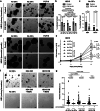A developmental biliary lineage program cooperates with Wnt activation to promote cell proliferation in hepatoblastoma
- PMID: 39567523
- PMCID: PMC11579301
- DOI: 10.1038/s41467-024-53802-4
A developmental biliary lineage program cooperates with Wnt activation to promote cell proliferation in hepatoblastoma
Abstract
Cancers evolve not only through the acquisition and clonal transmission of somatic mutations but also by epigenetic mechanisms that modify cell phenotype. Here, we use histology-guided and spatial transcriptomics to characterize hepatoblastoma, a childhood liver cancer that exhibits significant histologic and proliferative heterogeneity despite clonal activating mutations in the Wnt/β-catenin pathway. Highly proliferative regions with embryonal histology show high expression of Wnt target genes, the embryonic biliary transcription factor SOX4, and striking focal expression of the growth factor FGF19. In patient-derived tumoroids with constitutive Wnt activation, FGF19 is a required growth signal for FGF19-negative cells. Indeed, some tumoroids contain subsets of cells that endogenously express FGF19, downstream of Wnt/β-catenin and SOX4. Thus, the embryonic biliary lineage program cooperates with stabilized nuclear β-catenin, inducing FGF19 as a paracrine growth signal that promotes tumor cell proliferation, together with active Wnt signaling. In this pediatric cancer presumed to originate from a multipotent hepatobiliary progenitor, lineage-driven heterogeneity results in a functional growth advantage, a non-genetic mechanism whereby developmental lineage programs influence tumor evolution.
© 2024. The Author(s).
Conflict of interest statement
Competing interests: R.N. is a board member of Bio-Techne and a member of the Scientific Advisory Board of Surrozen Inc. The authors declare no other competing interests.
Figures








References
Publication types
MeSH terms
Substances
Associated data
- Actions
- Actions
- Actions
Grants and funding
LinkOut - more resources
Full Text Sources
Medical
Molecular Biology Databases

